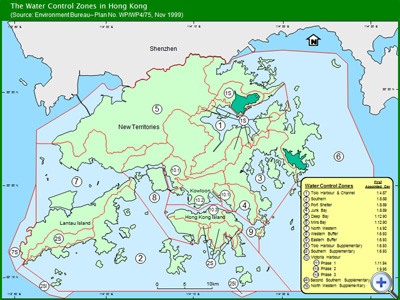|
Water Pollution Control Ordinance
The quality of the waters of Hong Kong had been deteriorating over the years as a result of water pollution arising from population pressure and economic growth in the past. In order to safeguard public health, to protect the fabric of the sewage collection and disposal systems and to contain the problem before the quality of the receiving waters deteriorates beyond natural recovery, it is necessary to implement controls on wastewater discharges.
The Water Pollution Control Ordinance (Chapter 358), was enacted in 1980 and amended in 1990 and 1993. It provides the main statutory framework for the declaration of water control zones to cover the whole of Hong Kong and the establishment of water quality objectives (WQO). The WQOs describe the water quality that should be achieved and maintained in order to promote the conservation and best use of the waters of Hong Kong in the public interest. Within each water control zone, all discharges or deposits are controlled by a licensing system. The Director of Environmental Protection (DEP) is the Authority responsible for licensing and controlling these discharges.

In Hong Kong, there are a total of ten water control zones and four supplementary water control zones:
- Tolo Harbour and Channel Water Control Zone;
- Southern Water Control Zone;
- Port Shelter Water Control Zone;
- Junk Bay Water Control Zone;
- Deep Bay Water Control Zone;
- Mirs Bay Water Control Zone;
- North Western Water Control Zone;
- Western Buffer Water Control zone;
- Eastern Buffer Water Control Zone;
- Victoria Harbour Water Control Zone (Phase One, Phase Two, Phase Three);
- Tolo Harbour Supplementary Water Control Zone;
- Southern Supplementary Water Control Zone;
- Second Southern Supplementary Water Control Zone; and
- North Western Supplementary Water Control Zone.
The delineation of water control zones and supplementary water control zones is shown on the map in the guide. Major areas within each control zone are listed in Annex 1. If you have any doubt as to whether a certain area is within a specific water control zone, you should contact the respective Regional Office of the Environmental Protection Department (EPD) for clarification.
The guide is for explanatory purpose only and is intended to explain the legislative controls under the Water Pollution Control Ordinance. In case of doubt, the reader is advised to consult the following ordinance, regulations and technical memorandum for details:
- Water Pollution Control Ordinance Chapter 358 (as amended by the Water Pollution Control (Amendment) Ordinance 1990 and 1993);
- Water Pollution Control (General) Regulations (as amended by the Water Pollution Control (General) (Amendment) Regulations 1990 and 1994);
- Water Pollution Control (Sewerage) Regulation;
- Water Pollution Control (Appeal Board) Regulations; and
- Technical Memorandum - Standards for Effluents Discharged into Drainage and Sewerage Systems, Inland and Coastal Waters.
The following booklets and leaflet provide guidance to prevent pollution:
Water Pollution Control Ordinance - Technical Memorandum
The Technical Memorandum is a guide for DEP in determining standards for wastewater discharge. It sets standards for different flow rates, different areas, for discharge to surface waters and sewers. The standards in the higher flow ranges are normally more stringent than those in the lower flow ranges. The Technical Memorandum also lists out the analytical methods used by the Government Chemist who is the analyst designated in the Water Pollution Control Ordinance.
Water Quality Objectives
The Water Quality Objectives (WQOs) are promulgated under the Water Pollution Control Ordinance (WPCO) (Chapter 358) to promote the conservation and best use of local waters in line with public interest. The current WQOs were established according to the water conditions and scientific knowledge. For instance, the Water Quality Objective (WQO) for bathing water in Hong Kong was established on the basis of the results of epidemiological studies carried out in collaboration with local academics in the late 1980s. These epidemiological studies had been designed and conducted according to the guidelines and recommendations of the World Health Organisation.
Over the years, there has been significant advancement in water science and technology. New uses of our waters, such as marine parks and reserves for conservation and education purposes, have also emerged. The community is more aware of the need to protect our environment, and the public expect a higher quality water environment for recreational purposes such as swimming, sailing, diving and canoeing, for a better quality of life.
|